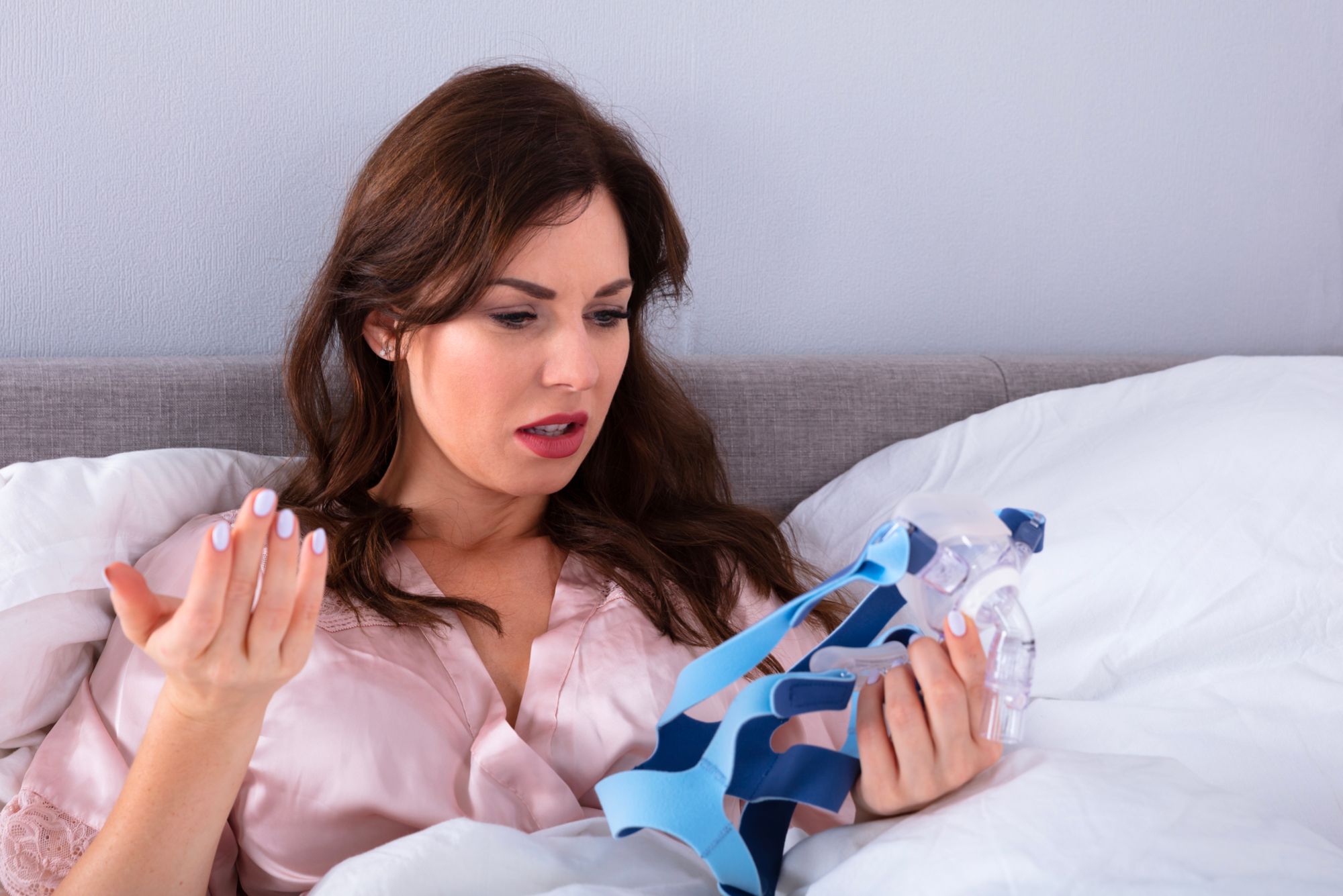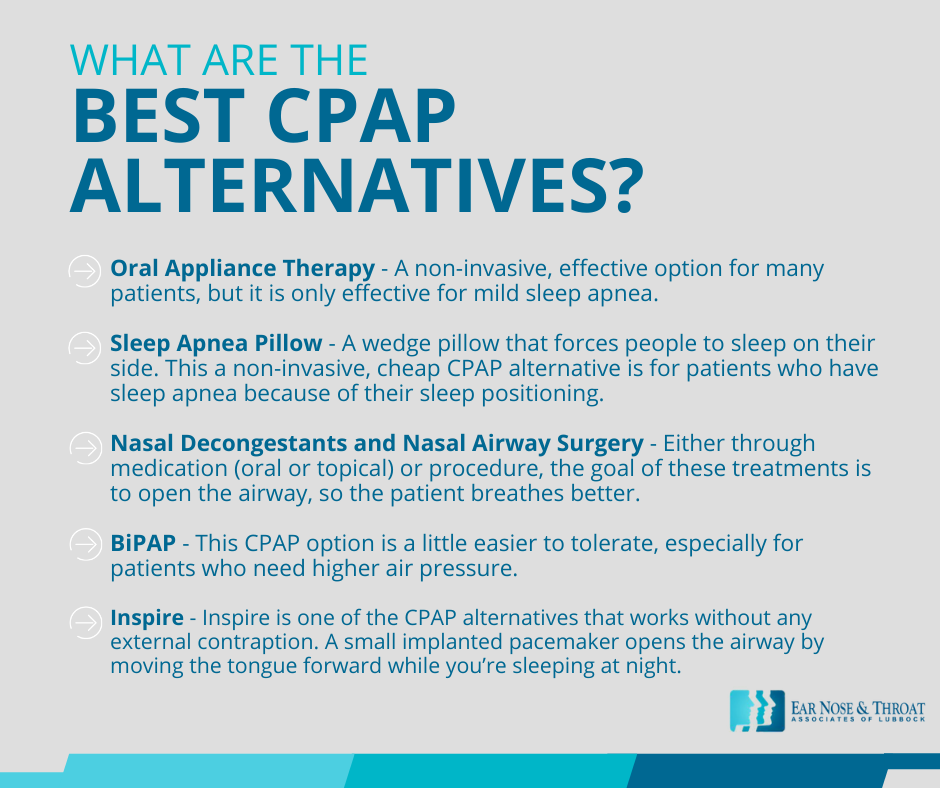What CPAP Alternatives Should You Consider? The Best Solutions for Sleep Apnea

What is CPAP? CPAP is an acronym that stands for Continuous Positive Airway Pressure and is usually a great solution for obstructive sleep apnea. It’s a logical treatment that uses a machine to produce air and send it to your nose through a hose and face mask to keep your airway open while you sleep. Yes, it’s been around a while, but it’s still the gold standard of sleep apnea treatment. In fact, we use CPAP standards as the bar by which we measure all non-CPAP alternatives to evaluate their effectiveness.
That being said, CPAP is difficult to tolerate. If you’re on CPAP, you may be able to relate to some of its problems.
Problems with CPAP
While CPAP can be highly effective, it only works if the patient can use it correctly.
For some, the face mask doesn’t fit well. CPAP offers alternatives of nasal masks, masks for the nose and mouth, or masks to cover the entire face. Even so, these options still do not accommodate for the facial structure of every patient. And when the mask doesn’t fit, it leaks.
When a CPAP mask leaks, it blows air into the eyes and can dry them out. This can become so extreme, patients need to consult with an ophthalmologist for dry eye solutions.
These leaks also make noise, which can irritate patients and keep them awake. Naturally, patients try to tighten the straps to prevent the leaks. But if they make straps too tight, they end up with headaches and strap indentations on their face.
Some patients who use only the nasal mask find it blows in their nose and right out of their mouth, which can be really frustrating and impair sleep.
But even patients who are able to find a mask that fits struggle with the complications of a CPAP machine. The CPAP is quite a contraption. It can be cumbersome to travel with, you can’t really talk once it’s on, and you have to keep it clean.
These problems, frustrations, and general inconveniences leave many patients looking for non-CPAP alternatives.
What Are the Best CPAP Alternatives?
Patients considering apnea CPAP alternatives have four primary options. Here’s a snapshot of each:
Oral Appliance Therapy
Dentists and oral surgeons use this appliance for mild sleep apnea. It works by positioning the teeth in such a way that the jaw is pulled forward while you sleep. When the jaw is pulled forward, the tongue is pulled forward too and the airway opens.
Pros
This non-CPAP alternative is a non-invasive, effective option for many patients, but it is only effective for mild sleep apnea.
Cons
For more severe cases, it doesn’t work. For some patients, this therapy causes soreness in the jaw and can create alignment issues with the teeth. Additionally, oral appliance therapy can be expensive and insurance may not cover it.
Sleep Apnea Pillow
This is simply a wedge pillow that forces people to sleep on their side.
Pros
This is a non-invasive, cheap CPAP alternative for patients who have sleep apnea because of their sleep positioning. Patients should know if this is a viable option for their situation based on the results of their sleep study. For some people, when they lay on their back, their sleep apnea gets worse. When they lay on their side, it goes away. So, a pillow that helps them stay on their side can cure their sleep apnea.
Cons
This isn’t an option for those whose apnea is not caused by sleep positioning.
Nasal Decongestants and Nasal Airway Surgery
Either through medication (oral or topical) or procedure, the goal of these treatments is to open the airway, so the patient breathes better. When we do this by surgery or medication, people feel like they have an improved quality of sleep. But if you were to repeat their sleep study, it’s often unchanged. Patients with apnea will find that they still have the same number of apneas each night. Their subjective sensation is the quality of sleep is better.
Pros
While this doesn’t eliminate apnea, it can improve CPAP compliance. If the nose is more open, the pressure on the CPAP machine doesn’t have to be as high. Plus, the patient just feels like they’re sleeping better. Another perk: they snore less.
Cons
If you do surgery, there’s recovery involved. Plus, even though the patient seems to be sleeping better, they have the same apnea they did before.

BiPAP
This is CPAP with bi-levels of air pressure. BiPAP offers one level for inspiration and another level for expiration. You inhale at one pressure, the pressure changes, and you exhale at a different pressure. It makes breathing with a CPAP more comfortable.
Pros
This CPAP option is a little easier to tolerate, especially for patients who need higher air pressure. When the pressure is high, it’s tough to exhale against a strong force of air. BiPAP minimizes that complication.
Cons
It’s still a CPAP machine, and it’s still not cheap. You need to buy the machine, hose, and mask, and you need to replace parts every year.
Inspire
Inspire (also knowns as hypoglossal nerve stimulation) is one of the apnea CPAP alternatives that works without any external contraption. A small implanted pacemaker opens the airway by moving the tongue forward while you’re sleeping at night.
Pros
You get off the CPAP machine. You just have to use a remote to turn it on at night. After surgery, there’s nothing complicated. You’re not attached to a hose all night and you can sleep in any position. Travel is simpler too — you only need to bring the remote, which is the size of a computer mouse. It’s the latest, greatest, and overall best CPAP alternative on the market.
Cons
Inspire does require surgery. It’s more invasive than other options and is only available for those with moderate-to-severe sleep apnea who have unsuccessfully tried CPAP. Additionally, patients must fall into a specific weight range to qualify for Inspire.
After surgery, however, it’s easy and effective.
If you’ve experienced problems with CPAP and are interested in finding out if Inspire or another non-CPAP alternative may work better for you, give us a call for a consultation.
Dr. Cuthbertson is a physician at Ear Nose & Throat Associates of Lubbock. He joined the team at ENT Lubbock from Houston, where he was chief resident of the prestigious Bobby R. Alford Department of Otolaryngology at Baylor College of Medicine. He is board certified in Otolaryngology and Head & Neck Surgery and has quickly built a reputation, not only as an extremely skilled surgeon, but as an approachable and compassionate clinician adept in the newest standards and technologies. Learn more about Dr. Cuthbertson.
Categories:








